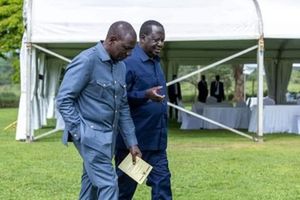
Kenya issued its fifth Eurobond bond on February 14.
The recent unexpected surge in the value of the shilling against the US dollar has evoked a range of emotions, leaving many feeling uncertain and confused.
For the government, the strengthening shilling serves as an affirmation of the country’s economic direction, portraying it as evidence of progress and a mark of investor confidence. But amidst this optimism, concerns linger among dollar holders, such as the diaspora community, about the longevity of this rally and its repercussions.
There are valid reasons to view the resurgence of the shilling as transitory rather than sustainable. This sudden strengthening was driven by short-term factors, not meaningful changes in the economic fundamentals. Although the National Treasury previously decried the high cost of borrowing in the commercial markets and promised to only seek concessional financing (bilateral and multilateral funding), it nevertheless reversed itself. The government recently sold a new $1.5 billion Eurobond with a 9.75 per cent coupon and a yield of 10.375 per cent, making it the most expensive bond issued thus far.
We are told these funds are earmarked for the retirement of a portion of Uhuru Kenyatta’s $2 billion bond, which carries a 6.875 per cent coupon rate. With a second infrastructure bond also successfully sold in the same week, this move adds to the government’s borrowing spree, pushing its total borrowing from various sources to a historic high in recent months.
The shilling’s response to the perceived “inflow” of $1.5 billion was predictable and consistent with trends. Unlike debt repayment, the transaction represented an economic gain, reflected positively on the revenue side of the country’s balance sheet. Ordinarily, it would have been converted into shillings before expenditure, resulting in heightened demand for the shilling and, subsequently, a rally in its value.
However, this “inflow” did not denote influx of actual dollars into the market; it’s merely transferred from one foreign lender to another without entering the currency exchange market, constituting an “on-paper inflow”. The question, then, arises: Why did the shilling strengthen if there was no real net inflow of dollars?
The sale of a comparatively expensive bond to retire a cheaper one alleviated pressure on the shilling, if only temporarily, and that was crucial in this context. By avoiding the need to sell shillings to acquire dollars for repaying the maturing Eurobond debt, the government mitigated the selling pressure on the shilling, resulting in its appreciation.
While the proceeds from the bond sale cover only 75 per cent of the debt, we assume the government already had about $500 million in reserves, reducing the need for a significant shilling-to-dollar conversion. This strategic financial manoeuvring, however, might prove to be a costly mistake: More shillings would inevitably need to be sold to purchase dollars to pay coupons and retire maturing Eurobonds, as well as fulfil obligations related to the SGR and other Chinese investments.
By resorting to taking out more expensive debt to retire cheaper ones, the government is engaging in financial mismanagement that fails to address the underlying issue of escalating debt in a sustainable manner. This strategy not only undermines fiscal prudence but also highlights its failure to enact measures that effectively tackle the looming debt problem.
There is a need for fiscal reforms, push for balanced budget and prudent debt management strategies instead of the reliance on short-term financial manoeuvres, which risk exacerbating the country’s fiscal challenges in the long run.
The burden of Eurobond financing was well summarised in an interesting segment aired on a local TV station, on the true cost of this $2 billion incurred by the Kenyatta presidency. The piece revealed a staggering reality: That while the initial $2 billion was equivalent to about Sh174 billion at the time, taxpayers have had to pay more than Sh465 billion, in principal and interest alone! What’s more, this debt remains on our books, accruing higher interest charges, due to refinancing.
Amidst these revelations, a crucial question arises: What exactly did the $2 billion fund? Was this “spent” on phantom projects like the laptops and stadiums, including one in Wote? To put it in perspective, this money could have funded the construction of three Nairobi Expressways. Yet there is no tangible evidence that the funds were deployed for the benefit of the broader society.
The absence of clarity regarding the utilisation of these funds should be a cause for concern for everyone. Without transparency, we risk finding ourselves saddled with immense debt without commensurate developments on the ground. Taxpayers must demand accountability.
Instead of celebrating more borrowing, and the temporary strengthening of the shilling, the public must demand accountability and transparency in the allocation and utilisation of these immense funds.
Mr Chesoli is a New York-based development economist and global policy expert. [email protected].










